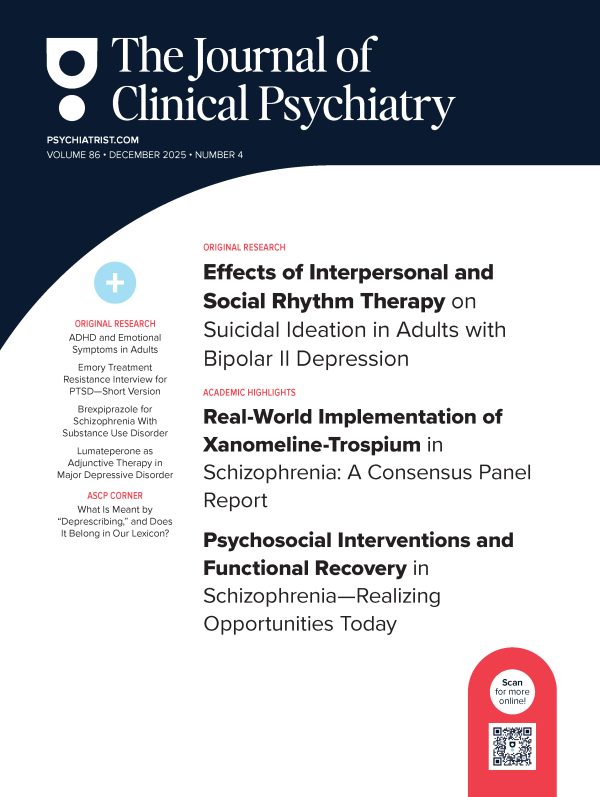The term clinimetrics was originally introduced in 1982 by Alvain R. Feinstein,1 the father of clinical epidemiology, to refer to a domain concerned with clinical measurements such as indexes, rating scales, global scores, clinical interviews, and other expressions that describe or evaluate symptoms, physical signs, and clinical aspects that are not encompassed by traditional diagnostic systems. Such clinical phenomena include patterns of symptoms, rate of progression of disease, severity of comorbid conditions, psychosocial issues, functional capacity, reasons for clinical decisions, and other features that entail major prognostic and therapeutic differences among patients who otherwise might seem similar at first just because they share the same medical or psychiatric diagnosis.2
The science of clinimetrics has been growing dramatically over the years,3 particularly in the last decade, with a threefold increase in the number of scientific publications. Its basic principles and domains have been further expanded and refined compared to its original formulation.3–5 The value of clinimetrics is not specific to the types and properties of clinimetric measurements but extends to a modern methodological perspective encompassing assessment strategies and clinical judgment, with substantial clinical implications for practice and research.3–5 Indeed, clinimetric research has supported a revolutionary approach to clinical medicine and psychiatry by broadly expanding the targets of clinical assessment in addition to customary taxonomy.3,4
Some trends and perspectives in the clinical process in psychiatry, with special reference to clinimetrics, have been outlined in a critical review published in this journal in 2012.6 The aim of this commentary is to illustrate the developments in clinimetric assessment strategies that have been made in recent years, with particular regard to the distinct features of clinimetric measurements, the domains of clinimetrics, and implications for clinical research and practice in psychiatry.
Features of Clinimetric Measurements
Clinimetrics addresses both observer- and self-rated methods, and it may be applied to a variety of data gathered through observation, clinical interviewing, and physical examination.2 Observer-rated methods mostly rely on the interviewer’s experience and clinical skills in data gathering,7 while self- rated methods allow to detect the patient’s subjective experience (eg, patient-reported outcome measures).8 Clinical interviewing represents an essential assessment method to understand how a person feels and what are the presenting complaints, obtain medical/psychiatric history, and evaluate individual attitudes and behavior related to health and disease.7 Discrepancies could emerge between the patient’s clinical state according to objective measurements and his/her subjective perception of health, particularly in the context of recovery from a disease, as well as in the rehabilitation process.5
Reliability (including both inter-rater agreement and internal consistency) and validity of a scale are the main requirements for its standardization. Sensitivity, the ability of an instrument to discriminate between patients and controls and/or patients’ subgroups and to detect (even small) changes in treatment trials (ie, responsiveness), represents an essential clinimetric property.5 Yet, since responsiveness may be affected by nonspecific effects, it should be associated with the ability of a scale to discriminate accurately between distinct populations or clinical subgroups.5
While homogeneity of components and unidimensionality (as measured by Cronbach’s alpha and factorial analysis) have been generally regarded as basic psychometric requirements of a rating scale, in clinimetrics the heterogeneous features of clinical variables are emphasized, as item redundancy is likely to obscure the ability of a scale to measure clinical changes.2,5
Several clinimetric tools provide global ratings of clinical phenomena (eg, illness severity, degree of comorbidity, improvement after treatment) in an attempt to capture and synthetize diverse illness manifestations through a general index that is more meaningful than medical or psychiatric diagnoses.2,5
Further, according to the psychometric model, all items have the same weight, with no differentiation between major and minor symptoms. In clinimetrics, not all items have the same clinical importance, as occurs in clinical practice.2 Indeed, the Diagnostic and Statistical Manual of Mental Disorders appears to be in line with the clinimetric model as to criteria encompassing different domains, but the hidden conceptual model is psychometric, since the diagnostic threshold is based on the number of symptoms rather than their intensity or quality, in the same way that a total score of a rating scale derives from the sum of symptoms positively endorsed.3,4,6
The concept of incremental validity (the unique increase in information that is provided by a scale in order to qualify for inclusion in the assessment strategy) is another important, yet often overlooked, clinimetric principle.3–5 Indeed, the administration of several measurements regardless of their incremental value may result in inconsistent findings.5 Further, high correlation between two scales does not necessarily mean that they are characterized by similar discriminative properties; therefore, items that they do not share may be important in determining their differential sensitivity and in selecting the most appropriate instrument to be included in the assessment procedure.5
The Domains of Clinimetrics
Clinimetrics has substantially expanded the narrow range of clinical information that is generally gathered and used in research and practice. It may offer the opportunity of operationalizing and measuring unitary concepts such as euthymia,9 allostatic load,10 and behavioral toxicity11 combining various clinical manifestations that would be likely to be scattered, or even discarded.5
The clinimetric assessment method of staging defines the current extent of progression of a disorder according to a longitudinal view of illness course.12 While in clinical medicine it had achieved wide recognition, staging was largely neglected in psychiatry until its first introduction in 1993.13 Staging models have been developed and refined for a number of psychiatric disorders (eg, schizophrenia, unipolar depression, bipolar disorder, agoraphobia, panic disorder, anorexia nervosa),14 as well as for clinical phenomena such as treatment resistance and behavioral toxicity.11,15 Such an assessment strategy is in sharp contrast with the flat, cross-sectional view of traditional psychiatric nosography.3,4,6
Further, exclusive reliance on diagnostic criteria may obscure consideration of important psychosocial factors that affect illness course and management, subclinical distress and illness behavior, as well as psychological well-being and lifestyle.3,4,6 The integration of the Diagnostic Criteria for Psychosomatic Research (DCPR)16 allows to identify allostatic overload,10 demoralization,17 and the spectrum of manifestations related to illness behavior.18 This amount of information would not be gathered using traditional diagnostic systems.
According to clinimetrics, clinical reasoning does not end with a diagnostic formulation, but goes through a series of “transfer stations,” as a pause for verification or change to another direction, and relies on repeated assessments that may supplement or modify the initial evaluation as new symptoms emerge after a first course of treatment.19 The clinimetric perspective allows clinicians to make full use of all available information and provides the conceptual framework for subtyping broad diagnostic categories (eg, major depressive disorder), as well as for hierarchical organization of comorbid diagnoses (ie, primary/ secondary distinction) to yield meaningful prognostic and treatment indications.4–6
The clinimetric concept of comorbidity is not limited to disease entities, but refers to any “additional coexisting ailment” separate from the primary disease, even though this secondary phenomenon does not qualify as a disease per se.20 Macro-analysis21 is a clinimetric strategy that allows to establish functional relationships between co-occurring symptoms, syndromes, and problems and to define therapeutic targets accordingly. It was originally developed as an assessment method preceding cognitive behavioral therapy21 and subsequently extended to clinical evaluation as a clinimetric procedure for organizing data.4,6 A hierarchical organization of comorbid syndromes and symptoms can be performed by the clinician based on time of onset, urgency, and/or patient’s preferences and needs.4,6 As repeated assessments based on macro-analysis take place (eg, reassessment after the first course of treatment), therapeutic targets can be rearranged or modified in relation to the new individual clinical configuration (eg, antecedent agoraphobic avoidance may emerge only after acute-phase pharmacological treatment of a major depressive episode).4,6
Macro-analysis can be supplemented by micro-analysis,4,6,21 a detailed assessment of symptoms and their particular features (eg, onset and course of symptoms, environmental factors that worsen/ ameliorate symptoms, and impact on patient’s life). A number of clinimetric instruments are available for rating intensity, quality, and other characteristics of patient’s symptomatology.4
Implications for Clinical Research and Practice in Psychiatry
Clinimetrics offers the opportunity to overcome the biomedical disease model, expanding the domains of clinical evaluation to include measurable psychosocial factors.3,4 Indeed, treatment outcome can be conceived as the cumulative result of nonspecific interacting variables (such as living conditions, patient’s characteristics and health behavior, clinician’s attitude and treatment choice, illness features and previous treatment, and self-management) that are indeed fundamental elements of the treatment process, can be measured with appropriate clinimetric instruments, and may exert therapeutic or counter-therapeutic effects.5 A selected treatment may thus lead to clinical improvement in a particular subgroup of patients (and treatment setting), whereas in another may have no effects, or even worsen disease course.5
Clinimetric integration of diagnostic criteria may improve the quality of data gathering, enable organization of clinical information, and promote the use clinical judgment, with important implications for treatment selection and planning.4 Careful exploration of the individual characteristics and his/her enviroment, maintaining a longitudinal view of disorders, and referring to unitary concepts that provide incremental information to the clinician and potential direction for management, are all essential components for a personalized approach geared to the individual patient within the unique context of the clinician-patient interaction.4,7,22
The clinimetric approach provides the intellectual home for the reproduction and standardization of clinical observations and intuitions,5 and advocates the use of clinical judgment.22
Article Information
Published Online: September 22, 2025. https://doi.org/10.4088/JCP.25com16124
© 2025 Physicians Postgraduate Press, Inc.
J Clin Psychiatry 2025;86(4):25com16124
Submitted: August 31, 2025; accepted September 4, 2025.
To Cite: Guidi J. The emerging science of clinimetrics: implications for clinical psychiatry. J Clin Psychiatry 2025; 86(4):25com16124.
Author Affiliations: Department of Psychology “Renzo Canestrari,” University of Bologna, Bologna, Italy; Clinical Trials Network and Institute, Massachusetts General Hospital, Boston, Massachusetts.
Corresponding Author: Jenny Guidi, PsyD, PhD, Department of Psychology “Renzo Canestrari,” Viale Berti Pichat 5, Bologna 40127, Italy ([email protected]).
Relevant Financial Relationships: The author reports no financial or other relationship relevant to the subject of this article.
Funding/Support: None.
ORCID: Jenny Guidi: https://orcid.org/0000-0001-6815-2738
References (22)

- Feinstein AR. T. Duckett Jones Memorial Lecture: the Jones criteria and the challenges of clinimetrics. Circulation. 1982;66(1):1–5. PubMed CrossRef
- Feinstein AR. Clinimetrics. Yale University Press;1987.
- Fava GA. Forty years of clinimetrics. Psychother Psychosom. 2022;91(1):1–7. PubMed CrossRef
- Fava GA. Clinimetric integration of diagnostic criteria for a personalized psychiatry. Psychother Psychosom. 2022;91:373–381. PubMed CrossRef
- Fava GA, Sonino N, Guidi J. Measuring clinical findings: the value of clinimetrics. Postgrad Med J. 2025;1–7.
- Fava GA, Rafanelli C, Tomba E. The clinical process in psychiatry: a clinimetric approach. J Clin Psychiatry. 2012;73(2):177–184. PubMed CrossRef
- Fava GA, Sonino N, Aron DC, et al. Clinical interviewing: an essential but neglected method of medicine. Psychother Psychosom. 2024;93:94–99. PubMed CrossRef
- Carrozzino D, Patierno C, Guidi J, et al. Clinimetric criteria for patient-reported outcome measures. Psychother Psychosom. 2021;90(4):222–232. PubMed CrossRef
- Guidi J, Fava GA. The clinical science of euthymia: a conceptual map. Psychother Psychosom. 2022; 91(3):156–167. PubMed CrossRef
- Fava GA, McEwen BS, Guidi J, et al. Clinical characterization of allostatic overload. Psychoneuroendocrinology. 2019;108:94–101. PubMed CrossRef
- Fava GA. Discontinuing Antidepressant Medications. Oxford University Press; 2021. CrossRef
- Fava GA. Clinical use of staging in psychiatry. Psychother Psychosom. 2024;93(3):143–150. PubMed CrossRef
- Fava GA, Kellner R. Staging: a neglected dimension in psychiatric classification. Acta Psychiatr Scand. 1993;87(4):225–230. PubMed CrossRef
- Cosci F, Fava GA. Staging of mental disorders: systematic review. Psychother Psychosom. 2013;82(1):20–34 PubMed CrossRef
- Guidi J, Fava GA. The clinical inadequacy of the concept of treatment-resistant depression: innovative strategies in assessment and psychotherapeutic management. Clin Psychol Rev. 2025;120:102616. PubMed CrossRef
- Fava GA, Cosci F, Sonino N. Current psychosomatic practice. Psychother Psychosom. 2017;86(1):13–30. PubMed CrossRef
- Fava GA, Guidi J. Clinical characterization of demoralization. Psychother Psychosom. 2023;92(3):139–147. PubMed CrossRef
- Fava GA, Cosci F, Sonino N, et al. Understanding health attitudes and behavior. Am J Med. 2023;136:252–259. PubMed CrossRef
- Feinstein AR. An analysis of diagnostic reasoning. I. The domains and disorders of clinical microbiology. Yale J Biol Med. 1973;46(3):212–232. PubMed
- Feinstein AR. The pre-therapeutic classification of comorbidity in chronic disease. J Chronic Dis. 1970;23(7):455–468. PubMed CrossRef
- Emmelkamp PMG, Bouman TK, Scholing A. Anxiety Disorders. Wiley;1993: 55–67.
- Fava GA, Guidi J. The role of clinical judgment in psychiatry. Acta Psychiatr Scand. 2025. doi: 10.1111/ acps.70035. CrossRef
This PDF is free for all visitors!


